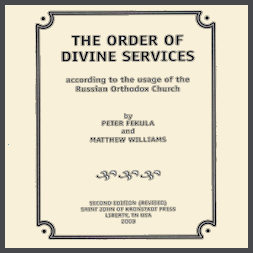|
The Typikón The Typikón (Greek: τυπικόν/Typikón, pl. τυπικά/typika; Slavonic: ѹставъ/ustav) is a book of directives and rubrics that establishes in the Orthodox Christian Church the order of divine services for each day of the year. There are a number of major Typikón traditions, but there are also many local variations, often codified into an official Typikón. Read more...
Commonly-Used Text of the Typikón
|
|
Background Information about the Typikón The word, Typikón, has the meaning of “following the order.” A Typikón exists for the liturgical services which is the established order for their celebration. A Typikón exists for a monastery which is the order followed in the daily and annual routine of those living there. A Typikón may be a complete, written document describing the “order” to the followed, or it may be an unspoken understanding, or it may be a combination of written guidelines and understood customs. A Typikón assumes the existence of liturgical books that contain the fixed and variable parts of these services. In monastic usage, the Typikón of the monastery includes both the rule of life of the community and the rule of prayer. Development of the Typikón
Background
Early Historical Development of the Typikón
The Lausaic History records that early Christian hermits prayed the Psalms, sang hymns, and recited prayers often in combinations of twelve. As coenobitic (community) monasticism developed following the example established by Saint Pachomius of the Thebaid (ca. AD 290–346) the cycle of prayer became more fixed and complex, with different practices in different places. The early Christian woman pilgrim to the Holy Land about AD 381–384, Egéria, Lausaic History records the following: By the fifth century, the region near Jerusalem had become a major center of pilgrimage and monasticism, and the daily cycle and order of services became highly developed. The order of services –Typikón – in the Palestinian region thus became increasingly influential throughout the Christian Church. The single, most-influential liturgical Typikón is that of Saint Savvas (AD 439–532) who standardized the order of life and services in the Palestinian monasteries. It is known simply as the Typikón of Saint Savvas (or Mar Sabbas) the Sanctified Monastery in Jerusalem and to this day regulates the order of Divine services worldwide in the Orthodox Church.
The Life of Saint Savvas the Sanctified
Thereafter Saint Sabbas traveled to Jerusalem continuing in the ascetic life in obedience to Saint Euthymius the Great. Saint Euthymius sent him to Abba Theoctistus at a nearby monastery with a strict cenobitic (community) “rule of life” – Typikón. Saint Sabbas lived in obedience at this monastery until the age of thirty. Saint Euthymius directed the life of the young monastic, and took him to the wilderness, setting out each January 14 where they remained until Palm Sunday. After Abba Theoctistus fell asleep in the Lord, Saint Savvas was given a blessing to live an eremitical (hermit) life in a nearby cave, leaving only to participate in the Divine Services. When his spiritual father, Saint Euthymius fell asleep in the Lord (ca. AD 373), Saint Savvas withdrew from the monastery and moved to a cave near the monastery of Saint Gerasimus of the Jordan. Disciples began to gather around Saint Savvas, who became spiritual father guiding them in the monastic life. As the number of monastics increased, the monastery which would become known to us as the “Great Lavra” or Monastery of Saint Savvas, began to take shape. The is regarded as being founded in the Kidron Valley, south of Jerusalem, in AD 484. As happens, the one who seeks the destruction of mankind tempted some of the fathers at the Lavra opposed the rule of Saint Savvas and demanded a priest as their abbot. In response, Saint Savvas quietly he withdrew to the New Lavra which he had built near Thekoa. Seeing the humility of His faithful servant, the One Who seeks the salvation of mankind, inspired Patriarch Salustius of Jerusalem to ordain Saint Savvas to the priesthood in AD 491. The Patriarch appointed Saint Savvas as Archimandrite in AD 494, overseeing all the monasteries in Palestine. Saint Savvas composed the first monastic rule of church services, the so-called Jerusalem Typikón, to guide all the monasteries. Saint Savvas fell asleep in the Lord on December 5, 532.
The Continuing Importance of the Typikón of Saint Savvas the Sanctified
The greatest theologian of the eighth century, Saint John of Damascus Saint Kosmas the Hagiopolite Saint Stephanos the Melodist, Saint Michael the Synkellos Saints Theodore and Theophanes the Graptoi (Branded) Saint Theodore, bishop of Karron Saint Stephanos the Womder Worker Saint Theodore, Bishop of Edessa and The Holy Martyr Michael The theological significance of Saint Savva Monastery to the Church was at a zenith when Saint John of Damascus solidly defended the place of holy icons in the Christian Church during the first period of Iconoclasm (AD 726-787). Again, during the second period of iconoclasm (AD 814–843), Saint Theodore the Studite summoned Saints Michael Syncellos, Theophanes and Theodore the Graptoi to Constantinople as confessors before imperial power of the truth of Orthodoxy. Saint Savvas Monastery also excelled in theological as well as liturgical documentation, copying, and translation during these centuries. It was the center of Georgian literature from the seventh to the tenth century, as well as being the center for translation of ecclesiastical writings from Greek into Arabic. Most notably, the hymns of the Savvaite hymnographers and the liturgical practices of Saint Savvas Monastery were widely disseminated by distinguished monastery founders from the 9th to the 13th century. The Typikón of Saint Savvas influenced, to a great or lesser degree, the subsequent monastic Typiká written by: Saint Theodore the Studite (9th century) Saint Paul the Younger of Mount Latros (11th century) Saint Lazaros of Mount Galesion (10-11th century) Saint Luke of Messina, Sicily (12th century) Saint St Neophytos the Recluse, Cyprus (12-13th century) Saint Nilos of Tamasia, Monastery of Maheras, Cyprus (13th century) The Typikón of Saint Savvas was not a static “rule,” but rather a “standard” for the development of subsequent services and practices. Saint Sophronius, Patriarch of Jerusalem (AD 560–638) revised the Typikón during the early sixth century. Saint John of Damascus (AD 675-749) expanded the material. Most significantly, Saint John of Damascus compiled, systematized, and organized the services books of the Orthodox Church according to the Typikón. These are exactly the service books used in every church today – the only “significant change” being their translation into various languages according to the pastoral needs of the faithful. Known variously as the “Jerusalem,” “Palestinian,” or “Sabbaite” Typikón, the “Typikón of Saint Savvas the Sanctified” remains in widespread and general use in most monastic communities worldwide as well as in parishes and cathedrals in the Slavic tradition.
The Studite, or “Constantinopolitan,” Typikón
A distinctive order of services developed at the “Great Church of Christ” in Constantinople which reflected its connection to the Roman emperor and its preeminence in Christendom. Known to liturgical scholars as the “Cathedral Typikón,” it was then known as the ἁσματική ἀκολουθία (asmatiké akolouthía, or “sung service”). Very few traces of this Typikón have survived to the modern era for two reasons. First, this Typikón was followed only in two churches, the Great Church of Christ, Ἁγία Σοφία– Holy Wisdom, and the cathedral of Saint Dimitrios in Thessaloniki. In the latter it survived until the Ottoman conquest and most of what is known about it today comes from descriptions in the writings of Saint Symeon of Thessaloniki. Second, and more significantly, the “Cathedral Typikón” was incorporated into the Studite Typikón. During the iconoclastic period, Saint Theodore the Studite sensed that some of the asmatiké akolouthía hymnography at both the Great Church and at the Studion monastery reflected certain non-orthodox concepts. He further discerned that the hymnology at Saint Savvas Monastery was a sure guide to true Orthodox theology, as he himself wrote to Patriarch Thomas of Jerusalem. The holy fathers of Stoudios synthesized the asmatike akolouthia of the Great Church with the Studion hymnography to produce the hybrid “Studite Typikón.” This is the “Byzantine Typikón” which has been handed down within the Greek Churches. It is the psalmodt and hymnology of the Palestinian, Savvaite Orologion grafted onto a framework of the services practiced in the Great Church. The Monastery of Stoudion in Constantinople therefore had a very sophisticated and rich liturgical practice, especially in regard to Lenten and Paschal services. The current Typikón of the Ecumenical Patriarchate, still titled the “Typikón of the Great Church of Christ,” is the 21st century reiteration of this tradition. The first modern printing of the Constantinopolitan Typikón was in 1839. Protopsaltes of the Great Church, Constantine Byzantios, composed and published it twice: in Greek as “The Ecclesiastical Typikón according to the Style of the Great Church of Christ” and also in Slavonic. In 1888, Protopsaltes of the Great Church George Violakis, corrected mistakes and ambiguities in the Byzantios text, and later published the completed and corrected Typikón as “Typikón of the Great Church of Christ” which is still in use today in churches of the “Byzantine” practice. This Typikón is often regarded as prescriptive and innovative but, as Bishop Kallistos Ware noted, “In making these and other changes, perhaps Violakes was not innovating but simply giving formal approval to practices which had already become established in parishes.” Differing in no significant way from the Savvaite Typikón, the editions published annually in recent years reflect three traditions, or practices (rites): the cathedral Typikón (of Saint George Patriarchal Cathedral), the monastic Typikón (for monasteries in Greece), and the parish Typikón for churches worldwide of the Ecumenical Patriarchate.
The “Slavic” Typikón Today
|


